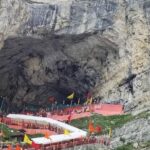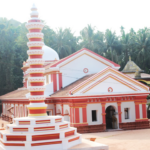The Mahakaleshwar Jyotirlinga, located in the ancient city of Ujjain in Madhya Pradesh, is one of the twelve sacred Jyotirlingas of Lord Shiva. It holds immense religious significance and is one of the most revered pilgrimage sites in India, with devotees visiting to worship Mahakal, the fierce form of Shiva associated with time, death, and the cosmic order.
Mythological Significance:
The legend of the Mahakaleshwar Jyotirlinga is deeply rooted in Hindu mythology, particularly in the Shiva Purana:
- Legend of King Chandrasena:
- According to a popular story, King Chandrasena of Ujjain was a devout worshiper of Lord Shiva. One day, a young boy named Shrikhar also wished to pray to Lord Shiva in the same way as the king but was driven away by the king’s guards.
- Disheartened, Shrikhar went to the outskirts of the city and started meditating in devotion to Shiva. At the same time, demon kings Dushan and Raktabija attacked Ujjain. To protect his devotee, Lord Shiva emerged from the ground in his fierce form, Mahakal, and vanquished the demons, saving the city and its people.
- The place where Shiva manifested became known as Mahakaleshwar, and the Jyotirlinga that appeared there came to be worshiped as Mahakal, the Lord of Time.
- Mahakal – The Lord of Time:
- The word Mahakal means “the great time” or “the eternal time.” Lord Shiva in his Mahakal form is believed to be the ruler of time and death, who governs the destiny of the universe. Worship of Mahakal is said to liberate devotees from the cycle of birth and death (moksha).
Historical and Cultural Importance:
- Ujjain, where the Mahakaleshwar Jyotirlinga is located, is one of the seven moksha-puris (holy cities) in Hinduism, where attaining liberation (moksha) is considered more achievable.
- The Mahakaleshwar Temple has been a center of spiritual and cultural life for centuries. It has been mentioned in several ancient texts and was visited by saints and scholars like Adi Shankaracharya.
Architectural Features:
- The Mahakaleshwar Temple is known for its Bhumija and Maratha architectural styles, featuring high shikharas (temple towers) and ornate carvings that depict various episodes from Hindu mythology.
- Temple Layout:
- The temple has three levels:
- Underground Sanctum: This houses the Mahakaleshwar Jyotirlinga, the main Shiva lingam that is self-manifested (swayambhu). This is the most important part of the temple, where devotees offer prayers and perform rituals.
- Middle Level: It houses the idol of Omkareshwar Shiva.
- Upper Level: It enshrines the image of Nagchandreshwar, which is open to the public only on Nag Panchami.
- The temple has three levels:
- The Shiva lingam at Mahakaleshwar is unique because it is the only Jyotirlinga that faces south (dakshin-mukhi), which is considered the direction of death and transformation. This is why Mahakaleshwar is often referred to as the Lord of Death and the Conqueror of Time.
Rituals and Worship:
- Bhasma Aarti: One of the most unique and important rituals at the Mahakaleshwar Temple is the Bhasma Aarti (offering of sacred ash), which is performed every day at dawn. During this aarti, the Shiva lingam is bathed in ash from cremation grounds, symbolizing Lord Shiva’s control over death and his role as the destroyer in the Hindu trinity (Trimurti).
- Maha Shivaratri: This is the most significant festival celebrated at Mahakaleshwar. Thousands of devotees flock to the temple to perform special prayers and participate in the night-long vigil, chanting hymns and offering prayers to Lord Shiva.
- Somvati Amavasya: Another important occasion when a large number of devotees visit the temple is Somvati Amavasya (New Moon Day falling on a Monday), considered auspicious for Shiva worship.
Spiritual Beliefs:
- It is believed that those who worship Mahakal with true devotion can overcome the fear of death and achieve moksha (liberation from the cycle of birth and death).
- The power of the Mahakaleshwar Jyotirlinga is believed to protect the city of Ujjain and its people from untimely death and calamities. Hence, the temple is not just a religious center but also a place of spiritual protection for its devotees.
Festivals and Celebrations:
- Apart from Maha Shivaratri, the temple celebrates several other festivals, including Shravan month (July-August), which is dedicated to Lord Shiva, and Kartik Purnima (November-December).
- A grand procession of Lord Mahakal, called the Sawari, is held every Monday during the month of Shravan, where the idol of Lord Shiva is taken through the streets of Ujjain with great devotion and fanfare.
How to Reach:
- The Mahakaleshwar Temple is located in Ujjain, which is well connected by road and rail to major cities like Indore, Bhopal, and Delhi. The nearest airport is in Indore, about 55 km away.
Conclusion:
The Mahakaleshwar Jyotirlinga is one of the most powerful and revered centers of Shiva worship. With its rich mythology, grand rituals, and spiritual energy, it continues to attract millions of devotees seeking the blessings of Mahakal, the eternal lord who governs time and death. Visiting this temple is considered a path to spiritual liberation, protection from untimely death, and divine blessings.













